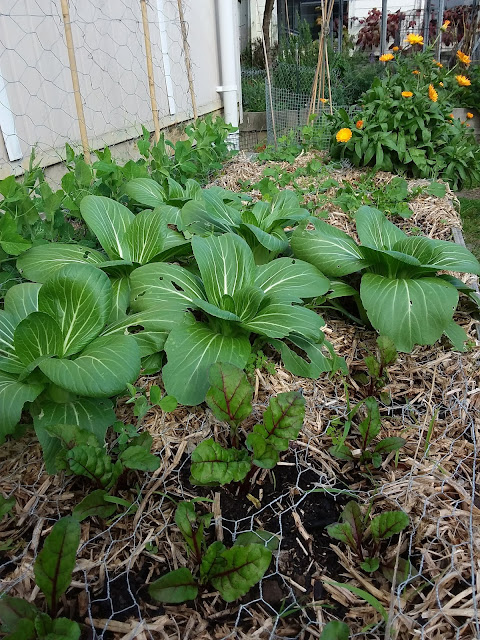What Do I Do With Them? Part 1
I talk a lot about growing veggies, but once you've lovingly nurtured them along, what do you do with the things? Some of the work involved in home grown veggies is the time spent picking, processing, and cooking them.
This is on my mind as I deal with my Spring broad bean harvest. For starters, there's a learning curve to knowing when to pick them. Some veggies are straightforward. Tomatoes, for instance. You've seen tomatoes all your life. You know what a ripe tomato looks like. You pick the things off the vine, and that is that. They look more or less like they did at the grocery store and you can pop them directly into your salad.
The grocery store doesn't sell broad beans. As legumes go, they are kind of their own thing, not really beans but not quite peas either. The first time I grew them, years ago, the advice I got was to shell them, cook them, and then remove the outer membrane of each individual bean. It took ages. So I didn't grow them again for years. But they are a great cover crop, so I decided to give them another go in an area that was going to get very little sun over the Winter.
This time, I learned that they can be eaten at three different stages. Little ones shorter than your finger can be eaten whole. Larger but not fully mature - when the beans are up to about four times the size of a pea - they can be shelled, cooked, and eaten much like peas. Bigger than that and the outer membrane becomes tough, necessitating the further step of removing it. You can pick up a lot from internet searches, especially looking at videos of what things look like at different stages and how to tell something is ripe. But it still takes some trial and error. I spent some time picking broad beans at different stages and doing some cooking experiments.
 |
| The broad bean patch, about a month ago when they were all flowers and not much beans yet |
My mom was over to help me in the garden last week, and she helped me harvest the broad beans. They were nearly as tall as me at that point, and they were shading out some of the sun-loving veggies I had planted next to them. Even though they still had beans developing and even a few flowers, it was time for them to go. My courgettes were looking pathetic in the shade. I had planted maybe three quarters of a square meter, and yet we still filled up a brown paper shopping bag with beans of every size.
 |
| The broad bean harvest |
I have spent about an hour today sorting and shelling broad beans and I have made my way through approximately half of them. Even this was a learning curve, the pods being different enough from peas that I was figuring out the most efficient method as I went along. I enjoy these kind of meditative veggie processing tasks but they are time consuming. I had time to consider how historically this kind of work was done collectively. How much faster it would have gone with even one helper. My mom told me about how she and her sisters would help her mother can fruit when she was a kid. Her job was chopping, peeling, etc. while others canned.
Sometimes my mom and I process produce together. It goes faster and the work feels lighter, easier. This Fall when my feijoa trees were overwhelming me with fruit, I would bring bags of them to my parents house, and Mom would help me cut and scoop out the insides. Some went into her freezer. Later, she would make jam and give some to me. This kind of sharing, even on a small scale, can be so rewarding.
Like everyone in this modern world, I have a lot going on, and I don't always manage to process the veggies on time. I usually know when it's the perfect time to harvest, but I may not find the time until next week. I try to give myself a break when this kind of time crunch leads to me not getting the most out of my veggies. It's easy to get stressed, but gardening is something I do for the love of it, so I try not to let it get to me. Sometimes I have to break down the processing into smaller steps. Like with my Winter greens. One day, harvest and place in the fridge. The next day, clean and de-stem. Another day, chop and cook. In the end, whatever we manage to eat out of the garden is something to be celebrated.
I am also lucky to be able to ask my mom for help once in a while. And if I've got more to harvest than I have time to deal with, then it is time to share. So if the burden of ripe veggies is overwhelming you, you could try dropping some off at your friends' doorsteps. And if you're very lucky, you may be able to interest a friend or family member in helping you shell some beans or dig up some potatoes - and give them some to take some home when they're done.
 |
| Cooked broad beans with salt, pepper, and butter |
Next time I will be talking about the other question of what to do with your veggies: cooking strategies.


Comments
Post a Comment